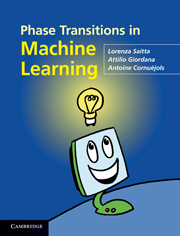Book contents
- Frontmatter
- Contents
- Preface
- Acknowledgments
- Notation
- 1 Introduction
- 2 Statistical physics and phase transitions
- 3 The satisfiability problem
- 4 Constraint satisfaction problems
- 5 Machine learning
- 6 Searching the hypothesis space
- 7 Statistical physics and machine learning
- 8 Learning, SAT, and CSP
- 9 Phase transition in FOL covering test
- 10 Phase transitions and relational learning
- 11 Phase transitions in grammatical inference
- 12 Phase transitions in complex systems
- 13 Phase transitions in natural systems
- 14 Discussion and open issues
- Appendix A Phase transitions detected in two real cases
- Appendix B An intriguing idea
- References
- Index
4 - Constraint satisfaction problems
Published online by Cambridge University Press: 05 August 2012
- Frontmatter
- Contents
- Preface
- Acknowledgments
- Notation
- 1 Introduction
- 2 Statistical physics and phase transitions
- 3 The satisfiability problem
- 4 Constraint satisfaction problems
- 5 Machine learning
- 6 Searching the hypothesis space
- 7 Statistical physics and machine learning
- 8 Learning, SAT, and CSP
- 9 Phase transition in FOL covering test
- 10 Phase transitions and relational learning
- 11 Phase transitions in grammatical inference
- 12 Phase transitions in complex systems
- 13 Phase transitions in natural systems
- 14 Discussion and open issues
- Appendix A Phase transitions detected in two real cases
- Appendix B An intriguing idea
- References
- Index
Summary
An important class of NP-complete problems is that of constraint satisfaction problems (CSPs), which have been widely investigated and where a phase transition has been found to occur (Williams and Hogg, 1994; Smith and Dyer, 1996; Prosser, 1996). Constraint satisfaction problems are the analogue of SAT problems in first-order logic; actually, any finite CSP instance can be transformed into a SAT problem in an automatic way, as will be described in Section 8.4.
Formally, a finite CSP is a triple (X, R, D). Here X = {xi|1 ≤ i ≤ n} is a set of variables and R = {Rh, 1 ≤ h ≤ m} is a set of relations, each defining a constraint on a subset of variables in X; D = {Di|1 ≤ i ≤ n} is a set of variable domains Di such that every variable xi takes values only in the Di, whose cardinality |Di| equals di. The constraint satisfaction problem consists in finding an assignment in Di for each variable xi ∈ X that satisfies all relations in R.
In principle a relation Rh may involve any proper or improper subset of X. Nevertheless, most authors restrict investigation to binary constraints, defined as relations over two variables only. This restriction does not affect the generality of the results that can be obtained because any relation of arity higher than two can always be transformed into an equivalent conjunction of binary relations.
Information
- Type
- Chapter
- Information
- Phase Transitions in Machine Learning , pp. 70 - 91Publisher: Cambridge University PressPrint publication year: 2011
